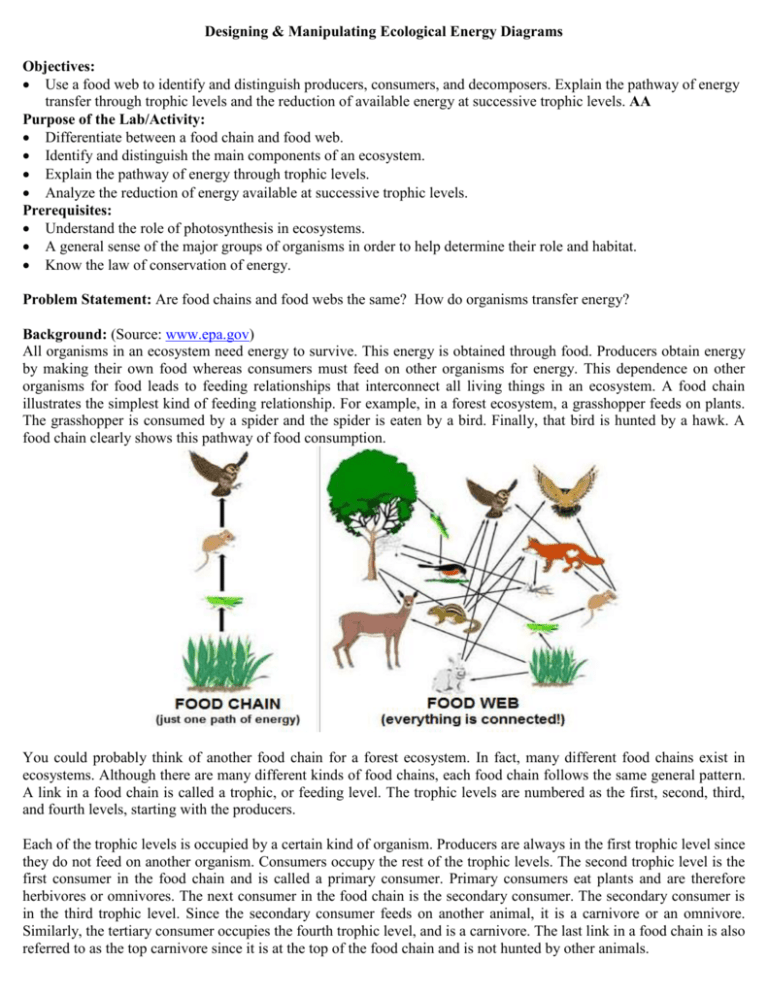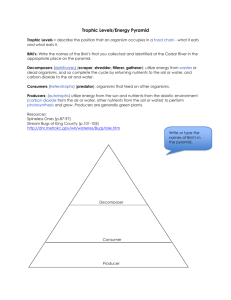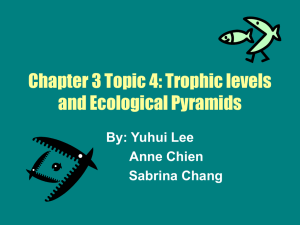Food Web Construction and Manipulation
advertisement

Designing & Manipulating Ecological Energy Diagrams Objectives: Use a food web to identify and distinguish producers, consumers, and decomposers. Explain the pathway of energy transfer through trophic levels and the reduction of available energy at successive trophic levels. AA Purpose of the Lab/Activity: Differentiate between a food chain and food web. Identify and distinguish the main components of an ecosystem. Explain the pathway of energy through trophic levels. Analyze the reduction of energy available at successive trophic levels. Prerequisites: Understand the role of photosynthesis in ecosystems. A general sense of the major groups of organisms in order to help determine their role and habitat. Know the law of conservation of energy. Problem Statement: Are food chains and food webs the same? How do organisms transfer energy? Background: (Source: www.epa.gov) All organisms in an ecosystem need energy to survive. This energy is obtained through food. Producers obtain energy by making their own food whereas consumers must feed on other organisms for energy. This dependence on other organisms for food leads to feeding relationships that interconnect all living things in an ecosystem. A food chain illustrates the simplest kind of feeding relationship. For example, in a forest ecosystem, a grasshopper feeds on plants. The grasshopper is consumed by a spider and the spider is eaten by a bird. Finally, that bird is hunted by a hawk. A food chain clearly shows this pathway of food consumption. You could probably think of another food chain for a forest ecosystem. In fact, many different food chains exist in ecosystems. Although there are many different kinds of food chains, each food chain follows the same general pattern. A link in a food chain is called a trophic, or feeding level. The trophic levels are numbered as the first, second, third, and fourth levels, starting with the producers. Each of the trophic levels is occupied by a certain kind of organism. Producers are always in the first trophic level since they do not feed on another organism. Consumers occupy the rest of the trophic levels. The second trophic level is the first consumer in the food chain and is called a primary consumer. Primary consumers eat plants and are therefore herbivores or omnivores. The next consumer in the food chain is the secondary consumer. The secondary consumer is in the third trophic level. Since the secondary consumer feeds on another animal, it is a carnivore or an omnivore. Similarly, the tertiary consumer occupies the fourth trophic level, and is a carnivore. The last link in a food chain is also referred to as the top carnivore since it is at the top of the food chain and is not hunted by other animals. Vocabulary: food chain, food web, food pyramid, producer, consumer, decomposer, detrivore, herbivore, carnivore, energy transfer, trophic level Extension: Food Chain Gizmo & Pet Pythons Gone Wild Video Materials (per group): One set of cards Colored Pencils 3 large cardboard papers Glue sticks Scissors Marker Pen/pencil Pre-Lab: 1. Why does the arrow in a food chain point towards the animal that eats the food? 2. Compare/contrast between a food web and food chain. 3. Compare/contrast between a pyramid of numbers, energy, and biomass? 4. About what percentage of energy, mass, or numbers go up to the next trophic level? Where does the rest go? 5. Define the vocab items 6. Draw / get 4 pictures of each of the animals that will be required on the food web Procedures: Mouse Eats: Grasshoppers Snails Salt marsh plants Hawk Eats: Shrews Mice rats Sparrow Eats: Crustaceans Salt marsh plants Grasshoppers snails Fish Eats: Crustaceans Salt marsh plants Salt water algae Salt water algae: Energy Source: Sunlight Basic Nutrients Food Web Creation Box Rat Owl Eats: Eats: Sparrows Rats Grasshoppers Sparrows Snails Ducks Salt marsh plants sandpipers Duck Sandpiper Eats: Eats: Crustaceans Crustaceans Salt marsh plants algae Algae Grasshoppers snails Shrew Small Crustacean Eats: Eats: Grasshoppers Salt water algae Snails mice Mushroom Decomposes dead land animals Bacteria: Decomposes organic matter back into basic nutrients Earthworm: Consumes large chunks of dead matter in the soil Heron Eats: Fish Grasshopper Eats: Salt marsh plants Sun Provides energy!! Salt marsh plants Energy Source: Sunlight Basic Nutrients Snail Eats: Salt marsh plants Salt water algae Basic Nutrients Come from decomposition Take out pictures representing the animals in the food web 1. Trophic Levels Through a Energy Pyramid: Using the third set of pictures, create a food pyramid with the animals. Remember to place all producers in the bottom level. On the next level, place primary consumers (eat only producers). On the third level, place any organism that eats primary consumers. On the fourth level, place any organisms that eat those, etc. Note: Some organisms are at different trophic levels depending on which chain you look at it. For the purpose of this activity. Place the animal on the highest level it occupies. As an advice. Just start EVERYONE lined up at the bottom, then move up anyone who eats someone else at that level and so forth. As you do this, you will complete the pyramid. The secret is not keeping any two animals in the same level if one eats the other. 2. Food Chain: Using the second set of pictures and the same color-coding as above (base it on information table and on the food web you designed), create a diagram that shows at least 6 different chains in the ecosystem. Use as many of the pictures as you can, but save 1 picture of each animal for the next part. If you run out of pictures (already used animal and want to use it again), try using a different chain or draw it again. 3. Food Web: Using the table above as reference. Arrange the cards into a logical food web, being sure to draw the arrows (pencil) in the appropriate direction showing energy flow. (Hint: Set up your web as you did the pyramid to begin with. It helps keep arrows clean) 4. Once you are sure of your design do the following steps for the pyramid, chains, and web! a. Use colored pencils to write animal names under the pictures. Names should be color coded as follows: Green = Producers Blue = Herbivore Yellow = Omnivores Red = Carnivore Black = Decomposers Orange = Detrivore Also underline any animals that are considered scavengers b. Use color pencil to color code arrows Green = Arrow represents link between basic nutrient and a producer, or energy exchange between abiotic factors and biotic factors (Lead from factors Blue = Arrow represents primary consumption, or energy exchange between a producer and a consumer (Hint: Any arrow leaving producers will be like this) Yellow = Arrow represents secondary consumption, or energy exchange between a primary and a secondary consumer (Hint: Any arrow leaving primary consumers will be like this) Orange = Arrow represents greater than secondary consumption (tertiary or higher), or energy exchanges between higher trophic levels (Hint: Any arrow leaving higher level consumers will be like this) Black = Arrow represents a nutrient recycling step taken by detrivore or decomposer (Hint: Arrows come from all to this and lead to nutrients) 5. Show your web, chains, and pyramid to your teacher. You will need to present / explain it so practice with another group first. 6. The teacher will then kill off one of the species in your web. 7. On a separate sheet of paper, discuss the impacts of the extinction of this species. How will their death impact the animals who feed on them? How will it affect the species that were preyed upon by them? Discussion Questions 1. What does the suffix “troph” mean? 2. What do you think a trophic level is? 3. Give an example of an animal that occupies different trophic levels depending on which food chain you look at. Write down the chains to illustrate your point. 4. Explain what would happen if all of the primary consumers became extinct. 5. Predict what would happen if a non-native species is introduced into the food web. 6. Explain why food webs with many species (biodiverse) are more resilient than those with few species. 7. Review your trophic pyramid, do you think there are more organisms at the base and less organisms as you travel up the pyramid (ignore the variety of types and think of quantity of numbers). Why is this the case? 8. Where is there more energy available at the bottom or at the top of the food chain / energy pyramid? Explain your answer 9. Based on your knowledge about energy levels in the each trophic level, explain why earth could support many more people if we ate at a lower trophic level. 10. Large predatory fish usually are found at the 3rd or 4th trophic level of an energy pyramid. a. Why do you think organisms at higher trophic levels tend to be larger (There are exceptions) b. Considering trophic energy/biomass limitations (see question 8), what does this mean in terms of how much they need to eat in comparison to animals at lower levels? c. Speculate about why there are usually few large predators (compared to smaller) 11. List 2 benefits and 2 drawbacks of society eating at a lower trophic level 12. Large predatory animals can also be problematic to eat because of bioaccumulation and biomagnifications of toxins such as lead or mercury in their habitats. What do those two big words mean and why should this be considered when discussing food chains and trophic levels. Mouse Rat Owl Mushroom Hawk Duck Sandpiper Bacteria: Sparrow Shrew Small Crustacean Earthworm: Fish Heron Grasshopper Sun Salt water algae: Salt marsh plants Snail Nutrients









